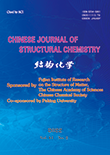Syntheses, Crystal Structures, Anticancer Activities and DNA-Binding Properties of the Dibutyltin Complexes Based on Benzoin Aroyl Hydrazone
JIANG Wu-Jiu, TAN Yu-Jun, MAN Jia-Tai and TAN Yu-Xing*
Chin. J. Struct. Chem. 2022, 41, 2202105-2202113 DOI: 10.14102/j.cnki.0254-5861.2011-3246
February 15, 2022
dibutyltin, complex, synthesis, crystal structure, DNA
ABSTRACT
Dibutyltin benzoin benzoyl hydrazone complex I [C6H5(O)C=N-N=C(Ph)CH(Ph)O]2[(n-Bu)2Sn]2 and dibutyltin benzoin salicyl
hydrazone complex II [2-(OH)-C6H4(O)C=N-N=C(Ph)CH(Ph)O]2[(n-Bu)2Sn]2 were synthesized and characterized by IR, 1H, 13C
and 119Sn NMR spectra, HRMS, elemental analysis and thermal stability
analysis, and the crystal structures
were determined by X-ray diffraction. The crystal of complex I belongs to monoclinic system, space
group P21/n with a = 11.1942(8), b = 10.4754(7), c = 23.6700(17) Å, b = 101.529(2)°, Z = 2, V = 2719.6(3) Å3, Dc = 1.371 Mg·m–3, m(MoKα)
= 0.966 mm–1, F(000) = 1152, R = 0.0458
and wR = 0.1312. The crystal of complex II is of triclinic system, space group P with a = 9.9960(4), b = 11.2466(4), c = 14.0509(5) Å, α = 69.4190(10)°, b = 70.0600(10)°, γ = 81.8090(10)°, Z = 1, V = 1389.69(9) Å3, Dc = 1.380 Mg·m–3, m(MoKα)
= 0.950 mm–1, F(000) = 592, R = 0.0284
and wR = 0.0690. In vitro antitumor activities of both complexes were
evaluated by CCK8 method against three human cancer cell lines (MCF7,
NCI-H460 and HepG2), and complex II exhibited better antitumor activity than I. The interaction between complexes and calf thymus DNA was
studied by UV-vis, fluorescence spectroscopy and viscosity measurements.








